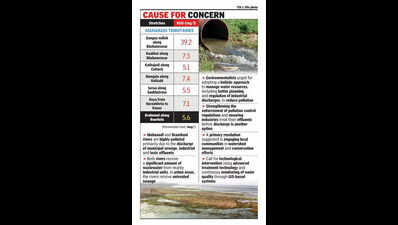- News
- City News
- bhubaneswar News
- 2 major rivers heavily polluted: OSPCB study
Trending
2 major rivers heavily polluted: OSPCB study
Bhubaneswar: Two major rivers in the state — the Mahanadi and Brahmaní — have dangerous levels of pollution caused by municipal sewage discharge and industrial effluents, a recent annual report by the Odisha State Pollution Control Board (OSPCB) has revealed.
The comprehensive study, which analysed water quality across 11 major rivers in Odisha, found high levels of biochemical oxygen demand (BOD), dissolved oxygen (DO), total coliform (TC), faecal coliform (FC), and faecal streptococcus at 16 monitoring stations.
In the Mahanadi, nine monitoring stations showed elevated levels of pollutants, particularly along the Kathajodi and Serua stretches in Cuttack, and the Daya and Gangua nullahs in Bhubaneswar. The report also found concerning levels of total coliform and faecal coliform exceeding permissible limits in Cuttack, Kanas, Bhingarpur and Gop.
Similarly, the Brahmaní river showed distressing results, with three monitoring stations at Panposh, Rourkela and Guradih nullah reporting high pollution levels. The study attributed the elevated pollution levels to untreated wastewater in the Mahanadi and industrial effluents in the Brahmaní.
Environmental expert Bijay Mishra emphasised the urgent need for action. "Pollution in the Mahanadi stems from wastewater discharge from Bhubaneswar and Cuttack. Industrial wastewater from nearby units affects the Brahmaní. This situation requires immediate and diligent attention."
The Mahanadi, the state's largest river with a catchment area of 65,628 sq km, and the Brahmaní, covering 39,116 sq km, play crucial roles in the region's ecosystem and water supply. Their deteriorating condition poses significant environmental and public health challenges for the state, according to experts.
The OSPCB submitted these findings to the Central Pollution Control Board (CPCB), highlighting the urgent need for the implementation of effective pollution control measures and proper wastewater treatment systems in the affected areas.
In a subsequent letter to municipal administrations, additional secretary of the water resources department, Arati Rout, while sharing the report, asked them to take necessary steps to prevent any drain water or untreated wastewater from entering any river or natural water bodies in order to keep them pollution-free.
End of Article
Follow Us On Social Media










